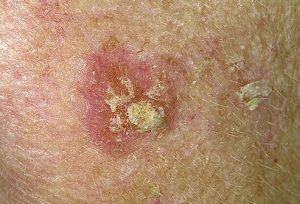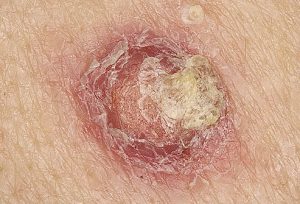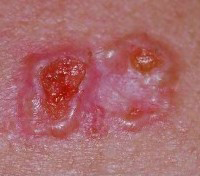
 Actinic Keratosis appears as crusty, “dry” scaly bumps that are rough textured and sandpaper-like to the touch. They can be skin-coloured, reddish or yellowish, tan or dark brown in colour. They can gradually enlarge, thicken and become more elevated and form “cutaneous horns”.
Actinic Keratosis appears as crusty, “dry” scaly bumps that are rough textured and sandpaper-like to the touch. They can be skin-coloured, reddish or yellowish, tan or dark brown in colour. They can gradually enlarge, thicken and become more elevated and form “cutaneous horns”.
They appear mainly on the face, especially on the nose, ears, temples, forehead, neck, and sometimes on or around the lips. They also commonly arise on the top of the forearms and hands and on the scalp of balding men.
TREATMENTS INCLUDE:
 Squamous Cell Carcinoma is a cancer that begins in the Squamous cells, which are flat, thin cells that resemble fish scales under a microscope. The earliest form of Squamous Cell Carcinoma is Actinic Keratosis or Solar Keratosis.
Squamous Cell Carcinoma is a cancer that begins in the Squamous cells, which are flat, thin cells that resemble fish scales under a microscope. The earliest form of Squamous Cell Carcinoma is Actinic Keratosis or Solar Keratosis.
Rapidly growing Squamous Cell Carcinoma forms a mound with a central crater and this is called a Keratoacanthoma. In short, Squamous Cell Carcinoma begins as a firm red nodule or scaly crusted flat lesion that often appears as a non-healing sore, bump or ulcer.
TREATMENTS INCLUDE:
Most Squamous Cell Carcinoma’s can be completely removed with relatively minor surgery. Depending on the size, location and aggressiveness of the tumour, treatment may include one or more of the following:
 Basal Cell Carcinoma is the most common type of skin cancer. A Basal Cell Carcinoma usually begins as a small, dome-shaped bump that has telangiectases usually visible with a device such as the Skinlite I. The texture of the bump is often “pearly”, shiny and translucent.
Basal Cell Carcinoma is the most common type of skin cancer. A Basal Cell Carcinoma usually begins as a small, dome-shaped bump that has telangiectases usually visible with a device such as the Skinlite I. The texture of the bump is often “pearly”, shiny and translucent.
It can be confused with a flesh coloured mole, so a biopsy is performed to verify this. Basal Cell Carcinomas can contain melanin, so that they look darker rather than shiny in some cases. Basal Cell Carcinomas grow slowly taking months to years to develop sizeably. They may have a small scab on their surface. It is often easily treated and cured in most cases. Although Basal Cell Carcinomas qualifies as a cancer, its harmful effects, if recognised and treated early, are usually minor.
TREATMENTS INCLUDE:
 Malignant melanoma is the most serious type of all skin cancers. It can arise on normal skin or from an existing mole. If not treated promptly, it can metastasize downward into other areas of the skin, lymph nodes or internal organs.
Malignant melanoma is the most serious type of all skin cancers. It can arise on normal skin or from an existing mole. If not treated promptly, it can metastasize downward into other areas of the skin, lymph nodes or internal organs.
Melanocytes are found throughout the lower part of the epidermis. They produce melanin, which is the pigment that gives skin its natural colour. When skin is exposed to the sun, melanocytes make more pigment causing the skin to tan or darken. Malignant melanoma is a disease in which malignant (cancer) cells form from these melanocytes.
Malignant Melanoma may have some or all of the following “ABCDE” features:
A – Asymmetry one half is unlike the other half.
B – Borders that are scalloped or indistinct.
C – Colour that is varied (brown, black, pink, blue-grey, white, or mixtures of these colours)
D – Diameter & dermascopic structure. Diameter that is greater than 6mm although these can be smaller. Dermascopic structure example, structureless, pigmented network, branched streaks, globules, dots, pseudopods.
E – Evolving, or change in a pre-existing mole. Any change in size, colour, elevation, or any new symptoms such as itching, bleeding, or crusting; particularly a mole that looks different from the rest.
TREATMENT: